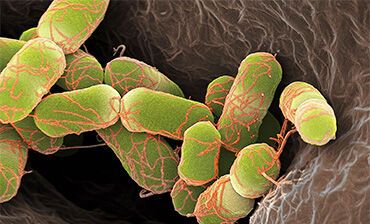Shiga toxin-producing Escherichia coli (STEC)

Escherichia coli (E. coli) are types of bacteria that are a normal part of the bacteria that live in the gut of human and animals. Some types of E. coli such as Shiga toxin-producing E. coli (STEC) can make a harmful substance (toxins) that can lead to a severe infection in humans.
The main source of STEC is grass-eating animals, especially cows. During the process of food production, meat, milk and vegetables may be contaminated with animal faeces with STEC if proper hygiene is not observed.
Symptoms appear 3 to 4 days after infection and usually include mild or severe bloody diarrhoea, normally without fever.
Key facts
Risk for people
About 8% of patients with STEC infection develop “haemolytic uraemic syndrome” (HUS), characterised by:
- kidney failure
- bleeding
- neurological symptoms
The mortality rate of HUS is about 3-5%.
While STEC affects people of all ages, children and elderly are at higher risk of severe disease
How it spreads
STEC infection is spread through contaminated food and water and by close contact with infected animals. Person-to-person transmission is possible among close contacts.
Vaccination and treatment
Treatment for STEC involves replacing lost fluids and keeping patients hydrated. Antibiotics are not generally advised as they can cause more severe illness.
Protective measures
Although there are safety measures in place in our food chains, the best ways to reduce the risk of STEC are:
- maintaining hand hygiene
- handling and preparing food correctly
- washing vegetables




